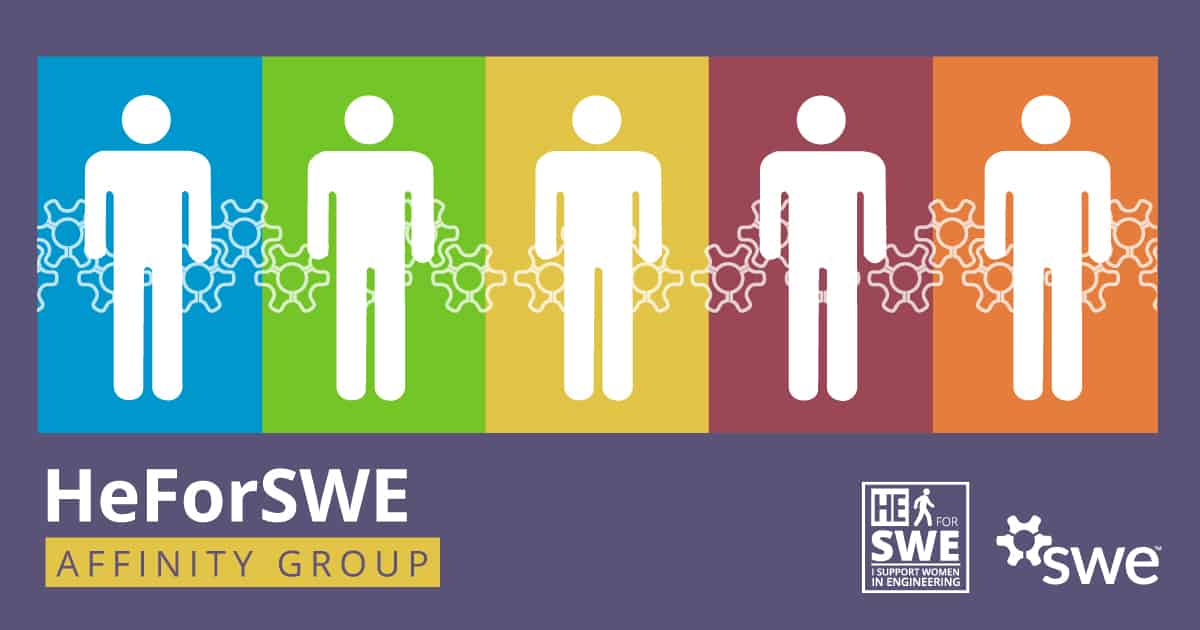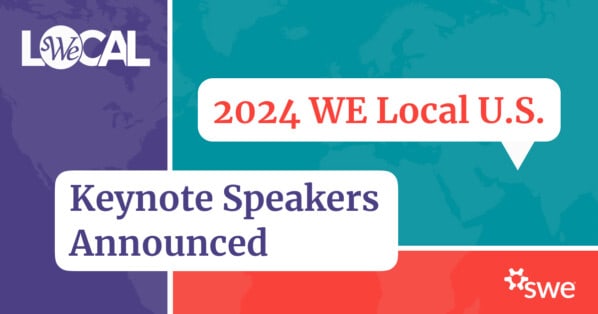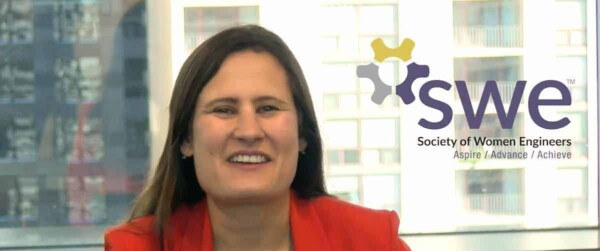As a part of the HeForSWE Affinity Group’s spotlight month, SWE will be highlighting professionals and male allies, discussing their perspectives on allyship in STEM. In this article, we will feature Tony Lushman (he/him/his), Joe Allen (he/him/his), and Chuck Lovell (he/him/his).
Tony Lushman (He/Him/His) – GE Aerospace
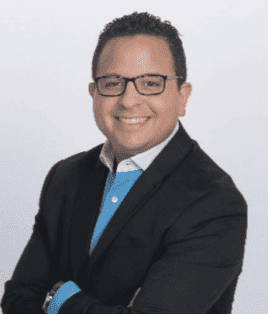
Tony Lushman is the Engineering Executive Leader for the Customer Technical Programs team within Regional & Business Aviation, based at GE Aerospace headquarters in Cincinnati, Ohio. Tony leads a team of engineers across the globe, located in Brazil, China, Mexico, & the United States, who are managing the shop visit workscope strategy across a fleet of over 7,500 regional engines, including the CF34-8C, CF34-8E, & CF34-10E engine programs.
Over his 15-year career at GE Aviation / GE Aerospace, Tony has obtained a wealth of experience in commercial engines, including roles in design engineering, repair engineering, product support engineering, project management, lifecycle cost management, and people leadership. Tony is originally from Panama and holds a Bachelor of Aerospace Engineering degree from Virginia Tech, a Master of Mechanical Engineering degree from Ohio State, and is a Veteran, having served in Afghanistan in support of Operation Enduring Freedom. Outside of work, Tony enjoys snowboarding & wakeboarding, traveling with his wife Jillian, and playing & reading with his son Matteo (2).
What does allyship mean to you?
To me, allyship starts with being present and follows with empathy. We all have a lot going on, but being an ally to me is finding the time to prioritize others and being present with them to help make a difference. When being present, you can learn about others and identify with them, which allows you to truly empathize and drive a cause forward. Combining these two aspects in day to day interactions with others is what makes allyship/advocacy have a real impact. In many cases, the impact even comes when you least expect it to.
What has driven & inspired you to want to support and become vocal advocates for women and other minorities in the STEM field?
Being Hispanic and in a STEM field, I always felt a sense of pride when you saw someone that looked like you or had a similar background being successful in a STEM field. For me, I have always wanted to reach back to the Hispanic population and help pull people up with me, being a guide or mentor in whatever way they may need. As I have grown in leadership, this has translated out of just the Hispanic side and into allyship/advocacy across different groups. Though I considered my journey to where I am today to not have been full of obstacles, there were still struggles along the way. If what I can do can help remove even just one obstacle for even just one person, then it is worth doing.
How do you engage other men to become advocates, recognize and want to support these initiatives?
The first thing that comes to mind is to lead by example, making sure that I am involved and engaged across the DE&I initiatives. I then try to be as vocal as I can, sharing learnings and some of the rewarding moments that I am lucky enough to be a part of. Sharing these in staff meetings, All Hands, or other settings I think opens the door for others to see how they can get involved and also get a little bit motivated to take that first step. Empathy I also think plays a role. You need to empathize with someone that may not have a natural inclination to support a group which they don’t see themselves as a part of. If you spend the time with that individual and get to know them, you can always find something that they are going through that can be relative to what another group of people may be going through. If you can tie those two together, you can create empathy and a new understanding with the other individual that can then drive engagement.
Can you give an example of a time you’ve implemented allyship actions in your workplace?
A few months back in conversation someone mentioned that the NP2 Mother’s room had a lock that required you asking the front desk guard to walk you back to the room and unlock it for you. This was just an extra step in an already busy day for women that need to use the Mother’s room to take, which made no sense. I set out to figure out how we could eliminate this step and create a few shared keys for the room or change the lock. As I did a little Gemba and walked down the room, I also noticed it wasn’t the nicest room and lacked some comfort. Women that use the Mother’s room are also usually trying to get work done in the room, and there was no good place to even put a laptop down. Working in Risk Benefit Analysis, we had some unique extra furniture. The furniture included a chair with integrated power, a foot rest, and an integrated swivel table. I borrowed a small furniture dolly and moved the chair into the 1st floor mother’s room, rearranging the room so it was more comfortable. I then did the same for the 3 other mothers’ rooms in other buildings. I hope that has made a small difference for those that use it!
How do you cultivate conversations in the professional environment about diversity and inclusion?
I think similar to what I mentioned before, it comes down to leading by example and being vocal. Talking about DE&I is good, but giving real examples through storytelling is great! The more that you can talk about this real example or bring others into the conversation to share their stories, the more of a meaningful conversation you can have. I think the Stronger Together initiative has been hugely successful in being able to achieve this and is a great model for others to follow. The second thing is we have to be ok with people making mistakes and saying the wrong thing. A lot of times people want to get involved or may have a question, but are afraid of saying the wrong things and being labeled for it. To a certain extent, we need to make sure others are comfortable expressing their understanding or asking questions without fear. They also need to be willing to listen & learn and those on the receiving end of the question need to allow them the space and then help to educate where it makes sense. This is a lot harder to put into practice, but it is something I strive to do every day in letting others know that it is ok to make a mistake when we talk within DE&I in the way something may be said or asked, because at the end of the day we are all still learning.
Joe Allen (He/Him/His) – GE Aerospace

An experienced finance professional with a passion for his community, Joe Allen joined GE in 1989 as part of GE’s Financial Management Program. He has held several progressive financial leadership roles across many GE businesses, served on the GE Corporate audit staff and helped pioneer GE’s shared service organization, Global Operations. As GE Aerospace’s prior Chief Diversity Officer, Joe led the creation and implementation of the business’s diversity program and established institutional accountability and methods for measuring progress. Joe is active in the Cincinnati community, lending expertise and insights to several non-profit organizations and serving as the City Lead for the Next Engineers Program.
What does allyship mean to you?
Allyship to me is providing visibility, awareness and most importantly support around creating a platform that is inclusive and equitable for all.
What has driven & inspired you to want to support and become vocal advocates for women and other minorities in the STEM field?
I would say the lack of representation of women and U.S. underrepresented minorities within the STEM field is what really drives me to want to be an advocate. A lack of understanding is what leads to inequalities and barriers for women and underrepresented minorities, and this is what drives me to want to create a world that is equitable and works for all.
How do you engage other men to become advocates, recognize and want to support these initiatives?
You have to set the example in all settings and be a role model. For instance, I help to kick-off our GE Aerospace MARC (Men Advocating for Real Change) sessions for the business every time these training sessions take place to talk about why it’s so important to be an advocate for others through mentorship, listening, and amplifying voices.
Can you give an example of a time you’ve implemented allyship actions in your workplace?
When I helped to start GE Global Operations, I created a reverse mentoring program. This was an opportunity for senior leaders to learn from employees at all levels of the organization by partnering with women, underrepresented minorities and others in the business to develop a deeper understanding of others and become more open-minded.
How do you cultivate conversations in the professional environment about diversity and inclusion?
First and foremost, you must start with listening to others, their stories and their perspectives to understand who they are and what experiences have shaped them. Next, you must aim to understand the differences between your experiences and theirs to give you some empathy and appreciation. Oftentimes we focus too much on our similarities and not enough on embracing our differences and leveraging that to make us better. In the end, we are all the same with a wide variety of different backgrounds and experiences.
Chuck Lovell (He/Him/His) – GE Aerospace
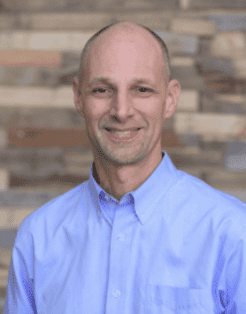
Chuck Lovell is a mechanical engineer with 28 years in GE, mostly in supply chain development, sourcing, and quality roles, at GE Healthcare and Aerospace. He also worked as a project manager for 8 years outside GE in 2 other medical device companies. He is energized by continuous improvement using the Lean toolkit and building diverse teams who work together in a shared mission, often under pressure or stress. He has lived outside his home country of the US on 3 occasions. This inspired a passion for diversity, inclusion and culture-crossing, as he often experienced both privilege and marginalization, sometimes in the same work day.
What does allyship mean to you?
Allyship means looking beyond how I experience the world, to notice and care about others who may experience life differently – and then invite them into the conversation and culture, with their unique gifts and perspectives. It requires curiosity, an empathetic courtesy, and humility. The latter of these 3 is the most difficult! But as an ally, I have a chance to empower others who might need an opening they don’t currently have. Come to think of it, many others have done the same for me over the years, whether it was intentional or not. It’s time for me to pass on the benefits!
What has driven & inspired you to want to support and become vocal advocates for women and other minorities in the STEM field?
I enjoy great conversations and fun enrichment from my friends and loved ones who are minorities (of many varieties). They make me better, and they make life richer. I want to welcome MORE of this to our high-performing workplace and personal lives.
How do you engage other men to become advocates, recognize and want to support these initiatives?
I keep talking it up – giving evidence of how advocacy makes the world better for everyone. No one loses! I also continue asking questions of any who will engage on the topic – because I keep learning. Perhaps my questions could help others learn something, too.
Can you give an example of a time you’ve implemented allyship actions in your workplace?
On several occasions, I have taken the opportunity to invite to a meal individuals who have a vastly different life experience than mine. I tried to ask curious questions and just listen to learn. I didn’t always agree with their perspectives, but these conversations were so very interesting and fun. As I better understand them, I am better able to appreciate their perspectives in the workplace.
How do you cultivate conversations in the professional environment about diversity and inclusion?
It can be an uncomfortable topic, so I try to raise it as often as I can – but in context. If another raises a subject which introduces D&I, I try to engage and expand the conversation. And I’m trying – continuously learning – to interrupt bias when I encounter it, first in myself, and when possible, with others. I recently took an online LinkedIn course on this, and it gave me some tools to use in those “in the moment” scenarios that we encounter when we are the least ready. I try to introduce the topic by explaining that I have a fascination with the topic and am trying to learn more, to be better. On most occasions, others are happy to engage if they sense that I’m serious about learning – and applying what I learn.
Opt into the HeForSWE Affinity Group email list by logging into your member portal and updating your Communication Preferences.
Author
-

SWE Blog provides up-to-date information and news about the Society and how our members are making a difference every day. You’ll find stories about SWE members, engineering, technology, and other STEM-related topics.

